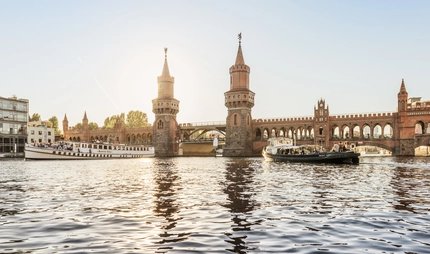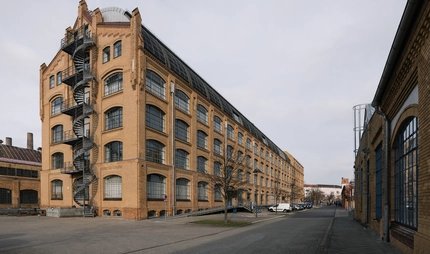
Former Kottbusser Ufer substation
Everything is illuminated
For the architect Hans Heinrich Müller, substations were more than just functional buildings: he gave each one an individual touch.
By order of the BEWAG (Berlin municipal electricity board), Hans Heinrich Müller designed a total of 40 substations in the 1920s. They were not meant to be purely functional buildings, Müller wanted more. His substation on the former Kottbusser Ufer, which is today called Paul-Lincke-Ufer, looks like a church in North German Brick Gothic and was soon called the “Cathedral of Electricity”.

Bathed in light day and night
“Berlin is modern, modern due to its light, its fight against the night ... . I have now been in Berlin for eight days and have not noticed the night at all. ... Berlin is a single block of light.”
This is how the French painter Fernand Léger expressed his enthusiasm for Berlin's brightness in the 1920s. At that time, it was not yet common for a city to be illuminated at night. It was new, modern, and exciting. And Berlin owed it to electricity.
Electricity can only be supplied with the appropriate infrastructure – including substations. They reduce the voltage of electricity generated in power plants, enabling it to be used by industrial end users or private households.
Demand for new substations. In 1920, the Prussian State Assembly united the core city of Berlin with Charlottenburg, Neukölln, Spandau and other towns in the surrounding area to form Greater Berlin. This made the city the third largest metropolis in the world. However, it still lacked a common infrastructure, so BEWAG tasked Hans Heinrich Müller with setting it up.

Functional building with ambition
The substation erected on Kottbusser Ufer between 1926 and 1928 was the first to be built in the south-east of the new metropolis. The building resembled a nave with a bell tower.
However, Müller's substation was not a historicist building but a work of modernism. The building rests upon a steel skeleton and the brick façade is superimposed. Although Müller focused on the classical Brick Gothic style, he experimented with it all the same. The bricks have nuances of colour that make the façade appear less severe and the windows, which vary in size depending on the floor, also break up the massing of the building. The architect integrated expressionistic segments such as the dentil cornice into the façade.
Müller took care to adapt the height and orientation of the substation to the surrounding buildings. As a result, the building does not appear isolated despite its monumentality. The rooms and layout are geared towards its function: the architect grouped the transformer and cooling wing, phase shifter and machine hall, control room, switch house, residential house, and self-supply wing around a rectangular courtyard.
The substation on Kottbusser Ufer survived the Second World War. BEWAG closed it down in 1989, and it has meanwhile been restored as a listed building. While you won't find any cables and machines there today, you will find an event location and the Volt restaurant.
Our tips for nearby the former substation on Kottbusser Ufer
You can discover further Berlin Modernism landmarks not far away. To visit the Brew House in the former brewery at the KINDL – Zentrum für zeitgenössische Kunst (KINDL – Centre for Contemporary Art), take the U-Bahn line 8 from Schönleinstrasse U-Bahn station towards Rudow and get off after two stations at Boddinstrasse. Walk south along Hermannstrasse for a short distance and turn left onto Werbellinstrasse. You can get to Tempelhof Airport by walking north for one kilometre to Görlitzer Bahnhof. From there, take the U-Bahn line 1 towards Uhlandstrasse, change at Hallesches Tor to the U-Bahn line 6 going towards Alt-Mariendorf and then get off at Platz der Luftbrücke.
Practical information from visitBerlin
The former substation on Kottbusser Ufer is best reached by taking the U-Bahn line 8 to Schönleinstrasse. From there, you need to walk east for 600 metres until you get to your destination at the corner of Paul-Lincke-Ufer/Ohlauer Strasse. To explore the city by public transport, we recommend the Berlin WelcomeCard.



